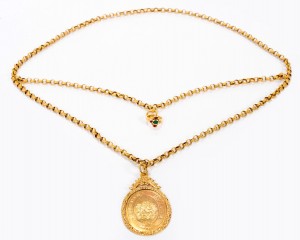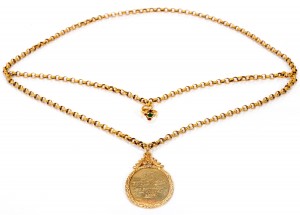From ancient times to the modern day, there are certain symbols of the Guildry of Stirling that form our traditions. The meaning and history of these are shown below.
The Guildry Symbol
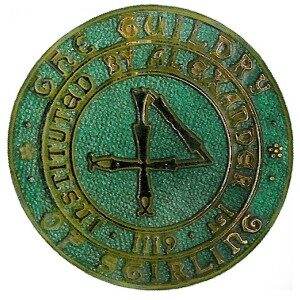 The reversed figure 4 has been adopted as the Guildry symbol. It’s a mark of great antiquity, and its adoption is of relatively recent date: otherwise it would have been on the Dean’s chain medal , commisioned 1822, instead of the Town’s emblem. It was possibly adopted in the middle of the 19th century This symbol can be found in many different places in Stirling. In the Holy Rude graveyard the reversed four can be seen on many of the headstones, symbolising merchants in Stirling. On the window of the Church of the Holy Rude it can again be seen, and it is also carved on the chairs in the Guildhall (or Cowane’s Hospital as it is also known). So when you wander around Stirling look above you at some of the carvings on the buildings, on the pavements, in the graveyards, at the Castle and many other places throughout the city and you will see things of interest.
The reversed figure 4 has been adopted as the Guildry symbol. It’s a mark of great antiquity, and its adoption is of relatively recent date: otherwise it would have been on the Dean’s chain medal , commisioned 1822, instead of the Town’s emblem. It was possibly adopted in the middle of the 19th century This symbol can be found in many different places in Stirling. In the Holy Rude graveyard the reversed four can be seen on many of the headstones, symbolising merchants in Stirling. On the window of the Church of the Holy Rude it can again be seen, and it is also carved on the chairs in the Guildhall (or Cowane’s Hospital as it is also known). So when you wander around Stirling look above you at some of the carvings on the buildings, on the pavements, in the graveyards, at the Castle and many other places throughout the city and you will see things of interest.
The Guildry Chain
The chain was made by Edinburgh jeweller John Mann, consists of 10 ounces of gold and incorporates 243 links. Also incorporated in the chain is a replica of the Guildry ring. The total cost including engraving is recorded in the Guildry accounts as £43.
The Guildry Pie
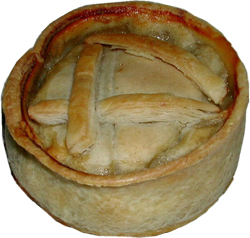 The pie has been a tradition from early times. At the end of each court Guild Brothers enjoy a refreshment accompanied by a Guildry Pie. The pie has been a tradition from early times. Guild Brothers were expected to take the pie home to their partner to prove that they had attended a court and not spent the evening in local hostelries! The Guildry Pie has the inverted four symbol incorporated in the crust.
The pie has been a tradition from early times. At the end of each court Guild Brothers enjoy a refreshment accompanied by a Guildry Pie. The pie has been a tradition from early times. Guild Brothers were expected to take the pie home to their partner to prove that they had attended a court and not spent the evening in local hostelries! The Guildry Pie has the inverted four symbol incorporated in the crust.
The Guildry Ring
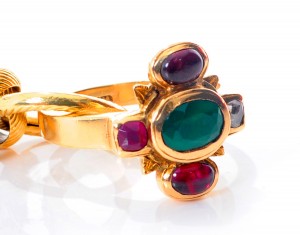 The Ring is the Guildry’s most precious possession. It is likely to have been given to the Guildry by King David II in 1360 when the King confirmed the Charter granted to the Burgh by King Alexander II. The earliest extant record of the gift is the Guildry Minutes of October 1630 when it was described as part of the Guildry belongings delivered by John Cowane, Dean of Guild, to his successor on his election as Dean. The Ring is the customary symbol under Scots Law which would accompany the gift of the Royal Charter on ratification. The Ring, which is kept in an Edinburgh Bank for safe keeping, is of gold set with five jewels in the form of a cross, a ruby, an emerald, a garnet, a purple stone and a crystal. The outer side of the band is inscribed “YIS FOR YE DEINE OF GEILD OF STIRLING”. A replica of the Ring is attached to the Dean’s Chain of Office and the real Ring has seldom been on view, although it was exhibited to the public at the Guildry’s exhibition on the occasion of its 750th Anniversary in 1976.
The Ring is the Guildry’s most precious possession. It is likely to have been given to the Guildry by King David II in 1360 when the King confirmed the Charter granted to the Burgh by King Alexander II. The earliest extant record of the gift is the Guildry Minutes of October 1630 when it was described as part of the Guildry belongings delivered by John Cowane, Dean of Guild, to his successor on his election as Dean. The Ring is the customary symbol under Scots Law which would accompany the gift of the Royal Charter on ratification. The Ring, which is kept in an Edinburgh Bank for safe keeping, is of gold set with five jewels in the form of a cross, a ruby, an emerald, a garnet, a purple stone and a crystal. The outer side of the band is inscribed “YIS FOR YE DEINE OF GEILD OF STIRLING”. A replica of the Ring is attached to the Dean’s Chain of Office and the real Ring has seldom been on view, although it was exhibited to the public at the Guildry’s exhibition on the occasion of its 750th Anniversary in 1976.
The Guildry Chair
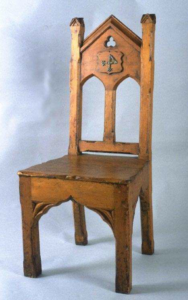 The Guildry Chair
The Guildry Chair
The Guildry Window
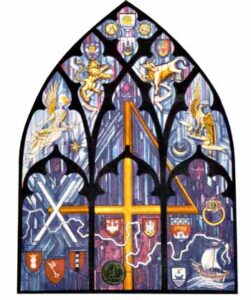 The design of the tracery of the Guildry window is a beautiful example of the richness of the imagination of medieval craftsmen. Much of medieval art is inspired and controlled by the mystical power of number symbolism, and an analysis of the geometry of this window shows that the whole design is controlled by the numbers 3 and 4. These numbers were the inspiration of the stained glass. The dominant motif is the reversed 4, which is the merchants’ mark that dates from the Middle Ages. The vertical and horizontal bars form the Sign of the Cross; an apporopriate symbol for the Kirk of the Holy Rude. The window faces south, therefore this golden cross, surrounded by deep blues, will shine on the floor of the nave. Since the word “nave” derives from the Latin for a ship it is an appropriate place for a window donated by the Guildry of Stirling, long associated with merchant trade.
The design of the tracery of the Guildry window is a beautiful example of the richness of the imagination of medieval craftsmen. Much of medieval art is inspired and controlled by the mystical power of number symbolism, and an analysis of the geometry of this window shows that the whole design is controlled by the numbers 3 and 4. These numbers were the inspiration of the stained glass. The dominant motif is the reversed 4, which is the merchants’ mark that dates from the Middle Ages. The vertical and horizontal bars form the Sign of the Cross; an apporopriate symbol for the Kirk of the Holy Rude. The window faces south, therefore this golden cross, surrounded by deep blues, will shine on the floor of the nave. Since the word “nave” derives from the Latin for a ship it is an appropriate place for a window donated by the Guildry of Stirling, long associated with merchant trade.
The Window Designer
Crear McCartney, who designed the Guildry Window, was born in 1931 in Symington, Lanarkshire. He was educated at Biggar High School. After service in the Royal Air Force he studied at Glasgow School of Art from 1950-55 and was awarded the Diploma in Design (Stained Glass). From 1955-60 he was Manager of the Stained Glass Studio at Pluscarden Abbey, Morayshire, then, following teacher training in Aberdeen, he was an art teacher in Elgin Academy and a principal teacher of art in Lesmahagow High School between 1961-88. Since 1988 he has been a freelance stained glass artist. During his career Mr McCartney has carried out commissions for 79 stained glass windows in Scotland, England and the USA. His principal work can be seen in windows for Pluscarden and Prinknash Abbeys, the west window of the 850th Anniversary of St Magnus Cathedral in Orkney and Dornoch Cathedral, the south transept window in Linlithgow, and other churches and chapels in Indiana, USA, Biggar, Stonehouse, Law Hospital, Wishaw, Nairn, Peebles, Prestopans, Ayr and Kirkconnel. Other commissions include a window for the offices of Scottish Malt Distilleries in Elgin and heraldic panels for the Norwich Union in Aberdeen. In 1989 he designed the RAF Memorial Window at St Eval, Cornwall.
The Guildry Officer’s Rod
 The Rod is the symbol of the authority of the Guildry Officer to act on behalf of the Dean and Council to maintain order among the Guildry members. This function was originally a full time occupation of the Guildry Officer and some of his duties were to summon Guildry members to attend the Dean’s Council when required by the Dean. He was also responsible for bringing “reluctant” members before the Council for punishment. The modern function of the Guildry Officer is restricted to ceremonial duties such as “Fencing the Court” at the meetings of the Full Courts. The Guildry Officer also presents the new members when they are called forward by the Dean when the business of the Court commences. Another duty of the Guildry Officer is to lead the Dean and Council on ceremonial occasions such as “Remembrance Day” services. The Rod was presented to the Guildry in December 1998 by Norrie Black, the then Guildry Officer and the Rod is fashioned from a hazel branch obtained from local woods around Stirling. The Rod is set with silver mounts and the top part consists of a gold reverse 4 on green jade and mounted in silver. The reverse 4 was fashioned from the gold of the wedding ring which belonged to Norrie’s grandmother who spent most of her early years living at the top of the town, raising a family of 13 children.
The Rod is the symbol of the authority of the Guildry Officer to act on behalf of the Dean and Council to maintain order among the Guildry members. This function was originally a full time occupation of the Guildry Officer and some of his duties were to summon Guildry members to attend the Dean’s Council when required by the Dean. He was also responsible for bringing “reluctant” members before the Council for punishment. The modern function of the Guildry Officer is restricted to ceremonial duties such as “Fencing the Court” at the meetings of the Full Courts. The Guildry Officer also presents the new members when they are called forward by the Dean when the business of the Court commences. Another duty of the Guildry Officer is to lead the Dean and Council on ceremonial occasions such as “Remembrance Day” services. The Rod was presented to the Guildry in December 1998 by Norrie Black, the then Guildry Officer and the Rod is fashioned from a hazel branch obtained from local woods around Stirling. The Rod is set with silver mounts and the top part consists of a gold reverse 4 on green jade and mounted in silver. The reverse 4 was fashioned from the gold of the wedding ring which belonged to Norrie’s grandmother who spent most of her early years living at the top of the town, raising a family of 13 children.


